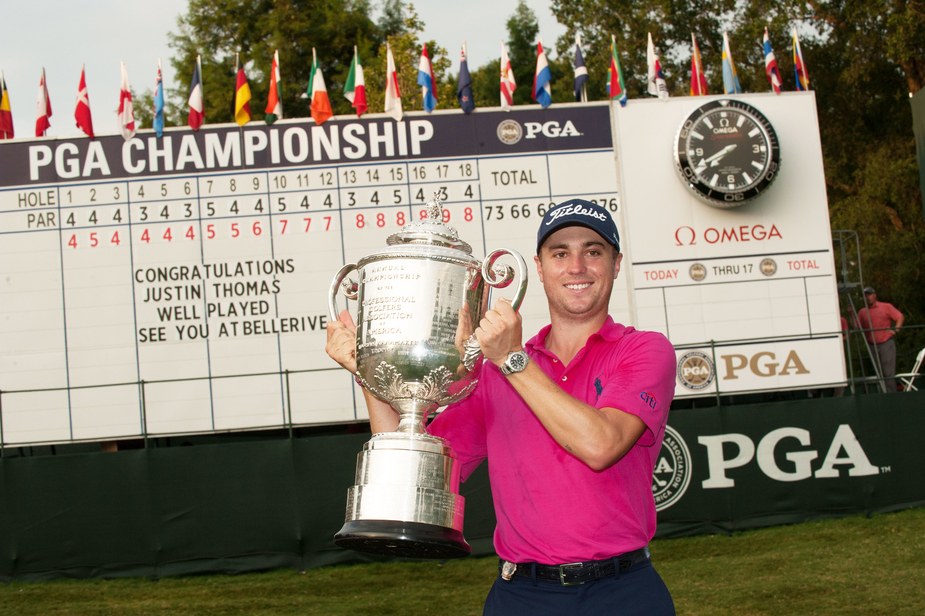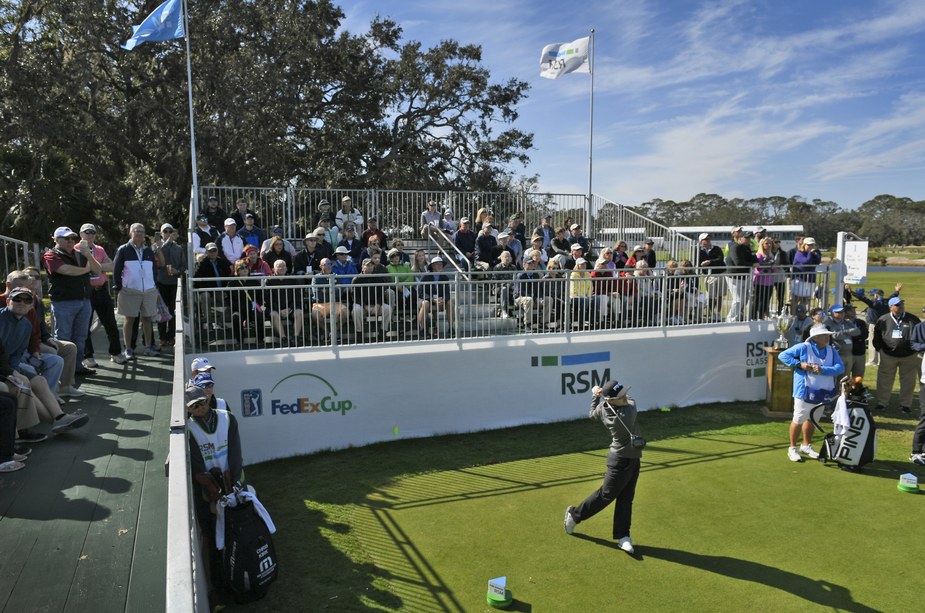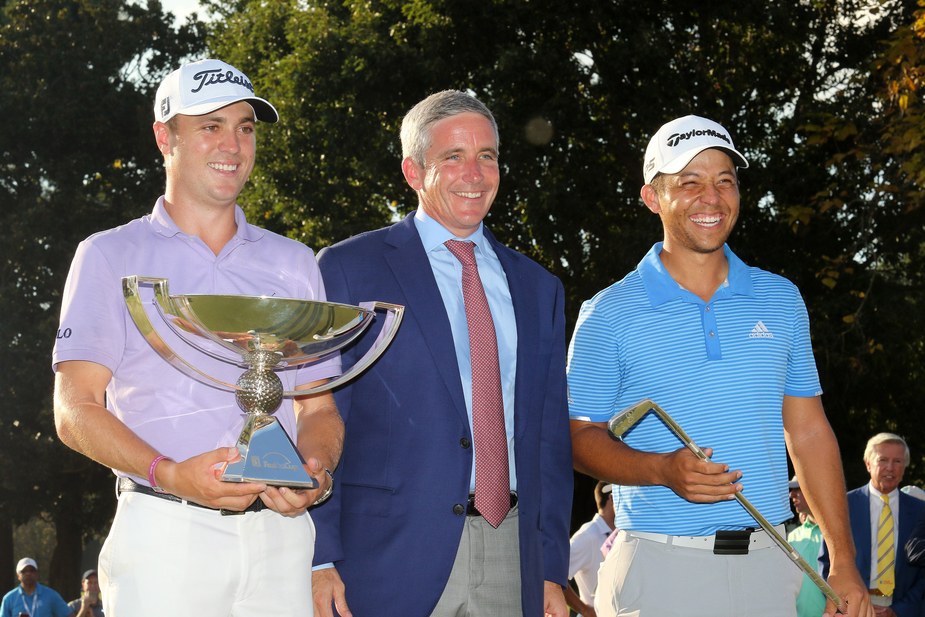The decision to move the dates of the US PGA Championship and the Players Championship in 2019 are the first steps towards revamping the tour season. But what’s next?
You can mark time by the cadence of the United States PGA Tour schedule. If it’s January, the boys are in Hawaii. February is the West Coast swing. March brings the Florida Swing, the Masters anchors the northern spring, and so on and so on. The generally static calendar has flaws, sure, but its rhythm and regularity provided a comfort to players and fans alike.
All this explains why, when word spread in 2017 of an upcoming schedule change, it was not as much a shake-up as it was a seismic wave. After years of speculation, PGA of America chief executive Pete Bevacqua confirmed that, beginning in 2019, the association’s oldest competition, the US PGA Championship, would move from its traditional August date to late May. To make room, US Tour commissioner Jay Monahan simultaneously announced the Players Championship would surrender its May spot on the calendar and return to its first home in March.
For these two stakeholders, the benefits of the concurrent moves were clear. The PGA of America won’t have to worry about tinkering with championship dates every four years to accommodate golf in the Olympics. Additionally, handing out the Wanamaker Trophy in the spring should increase the championship’s profile, which, frankly, sits behind its Major brethren.
“I think it will be a really good thing for the PGA, because it would be earlier on in the rotation when there is maybe more excitement for the Majors,” Phil Mickelson said at Quail Hollow. “We get to August, and that excitement kind of dwindles a little. It’s at a time of year where golf seems to linger on, so maybe there will be more energy behind the PGA earlier in the year.”
For the tour’s part, this is only the beginning of a highly anticipated series of moves aimed at creating a more streamlined schedule that would bring the season to an earlier climax that wraps up golf’s postseason prior to the start of the college football and NFL seasons, avoiding the head-to-head competition with football for TV ratings.
“That’s certainly something that we would like to see happen,” Monahan said this year. “Having big events every month, culminating in the FedEx Cup playoffs in August prior to the NFL season, that would be a very powerful schedule.”
Expectations among tournament directors and others in the industry are that the new schedule will be in place for the 2018-’19 season, although there are several moving parts still to be determined. In the meantime, 40-plus tournaments wait to see how they fit into a new puzzle.
And what might the new calendar look like? Taking information from previously published stories along with our own reporting provides an educated look at the possible new configuration.
• • •

What constitutes an ideal schedule depends on who you’re asking. Yet even with the variety of wants from players, tournament officials and fans, Monahan’s assertion that every month should have a tentpole event is the foundation of a new structure, one that seemingly all constituents support. This need became particularly clear after the 2016 season, with the Rio Games shoehorned into the calendar and leaving a mere week between the British Open and PGA Championship. Not only did The Open steal some of the US PGA’s thunder, the taxing slate – three Majors, a WGC and the Olympics conducted in a 57-day span, to say nothing of the ensuing month-long FedEx Cup – left many players grumbling about too many big events in too small a window.
The new schedule appears likely to put those concerns to bed. Setting aside January and February, the backbone of the revamped schedule begins in March with TPC Sawgrass and the Players, followed by four straight months where a Major anchors play – April and the Masters, May and the PGA, June and the US Open and July and the British Open. The FedEx Cup Playoffs become August’s focus, with the season culminating on America’s Labour Day weekend in early September with the Tour Championship. (And for good measure, the rest of September is open for the Presidents Cup and Ryder Cup.)
Besides moving the playoffs up a few weeks, there’s a growing understanding that the tour’s postseason is likely to shrink from four events to three. The odd tournament out is believed to be the TPC Boston event, a decision many players deemed fait accompli at this year’s tournament. That Dell Technologies only signed on for a two-year sponsorship ending in 2018 hasn’t quelled such speculation. (Ironically, Monahan once worked at IMG Worldwide, which helped develop the Boston event.)

Speaking of FedEx, which re-upped its sponsorship of the Playoffs through 2027, reports are that the company, in leveraging its strengthened partnership with the tour, wants a WGC competition in its Memphis backyard. The idea would be dropping the St Jude Classic, which often attracts only a handful of marquee names because of its spot the week prior to the US Open, in favour of the Bridgestone Invitational’s WGC halo. Firestone Country Club has a rich history and is considered a favourite by the players, but potentially it could fall victim to corporate synergy.
Which brings us to an uncomfortable point. By pushing the FedEx Cup up earlier, simple maths tells you that there are fewer weeks to play the tour’s current slate of spring and summer tournaments. In all likelihood, be it moving from their traditional times or simply closing things down, there will be event casualties.
Although Colonial Country Club in Texas is a celebrated venue, sponsorship issues have cast a cloud over its future. Accusations that the tour is OK letting the Colonial fade away may well be exaggerated, but one could understand – against the backdrop of 2019’s change – why securing long-term financial backing could be problematic. Throw in the buzz surrounding the AT&T Byron Nelson’s arrival at trendy Trinity Forest in Dallas in 2018, the folks at Colonial find themselves in a pickle. (For what it’s worth, the Nelson is expected to move before the US PGA. But the idea that a Major would separate the Texas stops does little to alleviate Colonial worries.)
Of course, Colonial’s future may be saved by another event’s uncertain tomorrow. The fate of the National (formerly sponsored by Quicken Loans) has likely been decided, as financial woes – coupled with Tiger Woods moving his charity’s attention elsewhere – seems to have dampened its future. The event is on the 2018 calendar, but remains without a sponsor and a host course.
The March portion of the schedule also needs to be sorted out given the arrival of the Players. Expectations are that the WGC-Mexico Championship will head to February, and early word is that the Valspar Championship will go to the autumn, when it was played when it started in 2000. Meanwhile, some industry insiders wonder about the status of the Arnold Palmer Invitational. With its namesake gone, the tournament struggled to draw big names in 2017, and Bay Hill’s layout is one that some tour pros aren’t fond of. The tour isn’t expected to pull the plug on the API, but the tournament needs to show signs of life next year to ensure its future.
Also in the spring fog: the Houston Open. Shell dropped out as sponsor, and the event, which has settled into a spot the week prior to the Masters, does not have a title holder for 2018. Redstone Golf Club, which sustained damage during Hurricane Harvey this year but should be OK by April, is a course that some players like because it is set-up to resemble the conditions they’ll see at Augusta National. That said, if it returns in 2019, it looks likely to lose its pre-Augusta setting, with the Valero Texas Open moving to the first week in April.
We’d be remiss in forgetting to mention the Greenbrier Classic. The tour is committed to the West Virginia property after the area’s devastating flooding (and cancelled event) in 2016. In that same breath, with another summer tournament or two needing to accommodate the FedEx Cup’s August move, don’t be surprised if the Greenbrier reappears as an autumn event in 2019. There’s also rumblings that Quail Hollow, set to host the 2021 Presidents Cup, might be willing to forgo hosting the Wells Fargo Championship on an annual basis in favour of being one of a handful of rotating courses that holds the FedEx Cup’s BMW Championship.
• • •

Mind you, there’s one entity that won’t be going anywhere when the new schedule emerges: the wrap-around season. Although the autumn campaign has been the target of scepticism – don’t these events compete with the NFL and thus struggle to gain the attention of general sports fans, ask some – Monahan remains steadfast in its viability.
“I would say going back to the advent of the FedEx Cup, the wrap-around season has elevated all of our events,” Monahan noted this year. “I think that works very well for our product, and candidly, as a sport, a true international sport, being on all the time and showcasing the world’s best players over that period of time, we think is very helpful.”
It’s sentiment echoed by Nathan Grube, tournament director at the Travellers Championship.
“Some of the strengths in the longer season is that you get a chance to get to know the young stars sooner,” Grube said. “Some of the ‘Fall’ events have produced some great champions that have been introduced to the world. Making the season shorter may not have offered us that opportunity. It’s a good challenge to have where the game has so many young stars that are ready to win immediately.”
In turn, it’s likely that the “offseason” will remain modestly short. From the conclusion of the RSM Classic in November to the Tournament of Champions event at Kapalua in early January, the tour has a roughly six-week window without any official events, something some players have griped about.
“I would prefer that there was a real break with no events in the fall,” said Adam Scott at this year’s PGA. “Why not have a few months off and starve everyone of PGA Tour golf? If they run tournaments the whole time and [players] do take the fall off, then you are so far behind when you do come back. I don’t see the value in running tournaments all the time. It seems to weaken the overall product.”
“Why not have a few months off and starve everyone of PGA Tour golf? I don’t see the value in running tournaments all the time. It seems to weaken the overall product.” –Adam Scott
Monahan, however, contends that if players play 25 events a year, that means they have 21 weeks where they’re off. “That’s five months of free time.”
Indeed, players are independent contractors, possessing latitude to create their own schedule. A latitude they’ve taken advantage of. Rank-and-file players may feel compelled to fill up the calendar, but the tour’s star attractions are not grinding on a week-to-week basis. The top eight money winners in 2017 averaged just more than 22 appearances, meaning they skipped half of the tour’s events. Scott himself has averaged just 17 tournaments per season for the past decade.
Left unspoken but understood by all is that some golfers will pass up playing in that week’s tour event, whether that’s in the summer or the autumn. However, there are plenty of golfers looking for the opportunity to play on any given week, enough to make it worth the tour’s while to fill up as many weeks as possible with tournaments.
“There are too many world-class players looking for playing opportunities and too many communities that welcome the excitement of a PGA Tour event,” said Clair Peterson, tournament director of the John Deere Classic. “If a player needs a break, he can always take one.”
Peterson’s observation points towards a sincere threat to the tour. Within a day of the PGA of America and PGA Tour announcement in August, the European Tour revealed that it will move the BMW Championship – held at the tour’s Wentworth headquarters – to September starting in 2019. European Tour chief executive Keith Pelley specifically noted the change was a response to seeing a window of opportunity in September.
If the US PGA Tour created a more formal (and longer) offseason, there’s a chance players would use this down time to play other circuits, especially with many overseas events offering large appearance fees. In essence, the tour’s competitors would likely be cashing in on Monahan’s (hypothetical) magnanimity.
All this also makes unlikely another popular proposal among players: a mid-season bye week.
“I am not sure the regular tour is ready for a built in off week or scheduled break,” Grube said. “Sometimes the guys never know what is in store. They may think they know their schedule and then an injury or personal situation comes up and their schedule changes. With an event every week, you give the players opportunities and they can add events late if it works out. I am not sure a built in week off would change playing habits.”
Much like shrinking baseball’s 162-game schedule or football’s tedious preseason, the prospect of lost revenue would scare most of the powers that be from this scenario. The idea makes sense in theory; on paper, not so much.

To both Grube and Peterson, whose events recently took home “Best Of” awards at the tour’s annual Tournament Meetings, a schedule that can remain as full as possible offers the best chance for all events to shine. With more playing opportunities, golfers are more likely to diversify their itineraries.
“The enterprise is moving forward to make everyone’s future more secure,” Peterson said. “In short order you would be stabilising the marketplace by adding excitement to all events and value to all title sponsors.”
Still, with two of the biggest items commonly on the wish list – an offseason and a bye – off the table, how does the tour remedy the almost universally held opinion that the season feels “too long”? To Peterson, completing the FedEx Cup before football kickoff might be the only change needed.
“I think ending the FedEx Cup playoffs before Labour Day will be a good thing,” Peterson said. “It will take some of the late-season pressure off players, especially with the PGA Championship moving to May. The old schedule made it tough on the events that were not World Golf Championships, Majors or playoff tournaments. Those were the weeks where top players many times took off to rest. As a summer event that was negatively affected by that, we look forward to those big events being more spread out through the year.”
Adds Grube: “I think all the events have a unique place on the calendar and each one is important, but creating a clear conclusion to the regular season seems doable with the changes that have been discussed.”
But is it doable by 2019? That, in reality, is the biggest issue facing the tour moving forward. By all accounts, Monahan and his team know essentially where they want to go with the schedule, but time might make the changes arrive in stages rather than one complete move-in.
Yet that might not be such a bad thing, either. In many ways, it’s like moving into a house that needs some TLC. While not a finished product, there’s a sound framework with room to tinker. All that’s needed is a bit of vision.
